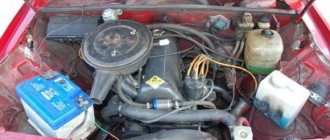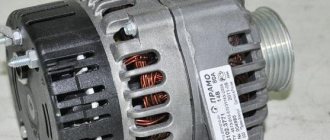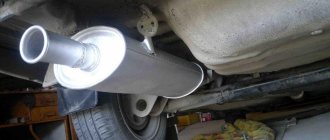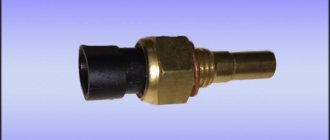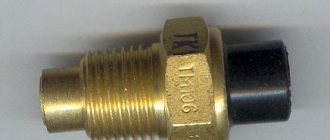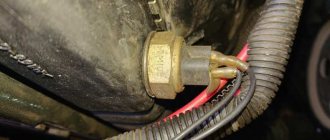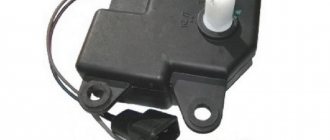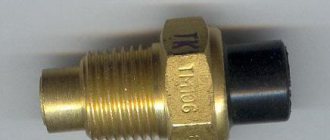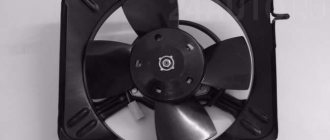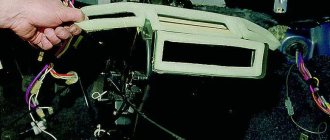The viscous coupling of a car fan is exactly the part that many car enthusiasts know firsthand, but know practically nothing about the features of its design. But this is a very interesting device in its simplicity, which does not break down very often - it is so reliable. However, a competent car enthusiast should know about the features of the design and operation of both large and small car components so that if they break down, he can quickly figure out whether a trip to the service station is necessary literally on the same day, or whether repairs can be postponed. Now we will try to figure out how the viscous coupling of a cooling fan works, what is the principle of its operation, and even how to repair it.
The operating principle of a viscous cooling fan coupling. Interesting theory
Most drivers are not familiar with the operating principle of the viscous cooling fan coupling. Therefore, if there are problems with this unit, mechanics begin to split hairs and reinvent the wheel. How to fix this part is legendary. Many people fall for them and end up with several more problems. Most often, drivers try to clamp the clutch discs. To achieve a permanent connection between the fan and the shaft. To do this, holes are made in the viscous coupling and bolts are screwed into them. This works for some time, but after 100-200 km of travel they are cut off, which can lead to damage to the radiator. This is due to the structural features of this structural element.
How it works
The operating principle of a viscous cooling fan coupling is directly related to its structure. Thanks to these features, the fan does not operate constantly, but depending on the temperature of the coolant. This allows the cooling system to operate as efficiently as possible. The viscous coupling itself consists of a non-separable oval-shaped body. There are two disks inside it. One of them is rigidly mounted on the fan impeller shaft. The other is mounted on a shaft connected to the drive. The discs are in a viscous silicone liquid, which is also located in a small reservoir. The design also includes a bimetallic plate.
This system works as follows. At normal air temperatures, the discs are either a short distance apart or slightly interlocked. In any case, one slips relative to the other. In this position the fan does not work.
An increase in temperature leads to the fact that the bimetallic plate, compressing, bends, squeezing liquid out of the reservoir. As a result, the pressure on one of the discs increases. It presses against the fan impeller disk and begins to spin it. The higher the temperature, the tighter they are pressed and the less they slip. When the temperature decreases, the plate returns to its original position. The pressure inside the chamber returns to normal and the fan stops.
The viscous coupling is installed together with the fan on the pump shaft. Sometimes this design can be seen on the crankshaft, it all depends on the layout of the given car model. A fan with a viscous coupling is much more efficient than a simple impeller mounted on a shaft. After all, it works as needed, without cooling the engine, for example, when warming up in winter. Most often, fans with viscous couplings are installed on cars that constantly operate under load:
- SUVs;
- Crossovers;
- Sports cars;
- Trucks.
This is due to more efficient cooling in all conditions.
Repair and replacement
Almost all modern cars are equipped with non-separable viscous couplings. Therefore, repair of this unit is impossible. But there are models mainly made in Germany with the ability to replace the bearing and add fluid.
This element has several faults. When a bearing fails, you can hear a characteristic howl from under the hood. If there is a lack of fluid, the fan's efficiency decreases. It begins to spin more slowly, until it stops completely. The same can be observed when disks are damaged.
Parsing
All work begins with removing the fan. It is usually secured with 3 or 4 bolts. By removing it, you can assess the condition of the coupling. If you have a collapsible model, you can try to repair the part. Before removing the bearing, you need to drain the liquid through a special hole. Next, use a screwdriver to remove the plate covering the bearing. And it is pulled out using a special puller. After this, a new spare part is installed.
The new bearing is pressed in using a special mandrel. You cannot do this with a hammer or hit the bearing in any way. This may damage it. A lack of fluid can be determined by the sudden stop of the fan after you turn off the engine. The motor also begins to overheat.
You should add special silicone-based viscous coupling oil. This is done using a special syringe. You can also use a medical one, the largest one you can find. Failure of the discs can only be determined by disassembling the clutch. They cannot be repaired.
Replacing the viscous coupling is not difficult. After removing the assembly from the engine, unscrew the fan impeller. Install a new coupling. At the same time, pay attention to the tightening of the bolts. They must be screwed in properly. After this, the fan is installed in place. In many cases, it is easier to immediately replace the entire viscous coupling without bothering with its repair.
Conclusion
. The cooling system is an important component of any car. At the same time, the efficiency of even the best systems is not maximum. The operating principle of the viscous cooling fan coupling makes this system the most efficient of all those currently in use. Knowing how such a clutch works, you can promptly identify its malfunction.
Functionality check
Viscous couplings of radiators are not so difficult to check. The operating manuals indicate that fan rotation should be checked first on a cold and then on a hot engine. At the same time, on a hot engine, when the engine is revved up, the rotation speed seriously increases, while on a cold engine it does not. The “folk” method of checking is very good, since it also involves caring for the engine cooling system. Here's what to do:
- Without starting the engine, try to rotate the fan blades with your hand or an improvised object. They should spin with little resistance, but without inertia;
- Start the engine and listen. In the first seconds, the motorist should hear a slight noise, which will gradually subside;
- After warming up the engine slightly, try to stop the blades with a folded sheet of paper. They must stop, but with a clearly noticeable effort;
- Remove the viscous coupling and warm it up strongly. Optionally, in boiling water. After this, the clutch should resist rotation. If it turns, there is practically no silicone liquid left inside. It is also recommended to remove the engine cooling radiator and wash it;
- Check the longitudinal play of the device. If there is one, the coupling must be repaired.
Please note that if one of the verification stages has not been passed, there is no point in going further along the list. However, it always makes sense clean the radiator
Viscous cooling fan operation
A viscous coupling, also known as a viscous coupling (from the Latin viscosus - viscous) is a mechanical device that transmits torque using a viscous fluid.
In this video, see what the clutch is in this device
The principle of operation of the viscous coupling is carried out thanks to a belt drive that connects the coupling rotor and the crankshaft pulley of the internal combustion engine. There are also car designs in which the clutch is installed directly on the crankshaft or camshaft.
In order to understand how a viscous coupling works, you need to understand what it consists of.
The device consists of:
- Spring.
- Bimetal plate.
- Inlet port B.
- Inlet channel A.
- Camera.
- Return valve.
- Return valve.
- Rear springs.
- Front reservoir.
- Rotor.
- Device body.
- Rotor shaft.
- Bearing shell.
- Rear reservoir.
- Rear plate.
- Rotor.
- Front plate.
- Lid.
Due to the complex design of the device, the price of a viscous fan coupling is relatively high.
Device and main components
Let's consider what components a viscous coupling consists of. The device consists of the following key elements:
- Hermetically sealed housing (since it is constantly filled with liquid, this part of the mechanism must be sealed to avoid leaks);
- Two packages of discs with perforations or ribs. One packet is the master, and the other is the slave. Regardless of the number of disk elements in each package, they all alternate with each other, due to which the liquid is mixed more efficiently;
- A dilatant fluid that transmits torque in a closed housing from one set of disks to another.
Each manufacturer uses its own base for the working fluid, but often it is silicone. When an organic liquid is vigorously stirred, its viscosity increases until it becomes almost solid. Also, modern viscous couplings are presented in the form of a drum, the body of which is attached to the impeller with bolts. In the center of the housing there is a freely rotating shaft with a nut, to which the drive pulley or the motor shaft itself is screwed.
How to check a viscous coupling
The resource of this device in the design of the car is designed to cover 200 thousand km.
To check whether the fan and clutch are working well, you need to know the signs of malfunctions of these parts:
- If the engine heats up quickly, then this is the first sign of a viscous coupling malfunction. This appears due to the release of the gel or the untimely operation of the bimetallic plates. In this situation, when the motor gets very hot, the fan spins at a low speed, or does not turn on at all.
- The cooling fan starts spinning when the engine is still cold. This occurs due to changes in the properties of the gel, hardening of the lubricant and failure of other elements of the viscous coupling.
Reasons for failure or poor performance of a viscous coupling:
- The resource has been exhausted.
- Mechanical damage.
- The bearing has expired or broken prematurely.
- Axial runout of the fan impeller. Part of the propeller blade is broken.
- Lack of lubrication of the coupling shaft.
- Contamination of the coupling connection.
Advantages and disadvantages of a fan driven via a viscous coupling:
The advantage of a viscous coupling is that there is no electronics or electricity involved.
- The viscous coupling provides more power, the fan rotates at a higher speed. If the clutch sits rigidly on the crankshaft of the internal combustion engine, then the rotation speed is very high.
The power of the clutch connected to the crankshaft is several kW (kilowatts). And the power of electric fans has a power of several tens of watts. Thanks to this, a fan with a viscous coupling is used in agricultural machinery, military equipment, and special equipment.
Disadvantages of viscous coupling:
- Complex design, more difficult to repair. It is cheaper to buy a new assembly assembly.
- Has good mass. The weight on the internal combustion engine crankshaft is significant.
- Switching on temperature control is not entirely correct. There are errors in turning the cooling fan on and off.
- At high speeds there is an increased noise level.
- According to the schedule, you have to refill with gel or oil with the required viscosity.
- The viscous coupling partially takes away the engine power.
This list of shortcomings of viscous couplings influenced the decisions of the owners of automakers. They refused to use such devices in passenger cars.
Selecting a new device
Like selecting any other part for a car, finding a new viscous fan coupling is not difficult. To do this, you can use the services of online stores. Even if the device that this or that store offers is too expensive, you can at least find out the catalog number of the mechanism. This will make it easier to find the product on other platforms. By the way, many online car stores offer both original spare parts and their analogues.
It is best to search for original products by VIN code (read about what information about the car it contains, as well as where to find it in the car, in another article ). Also, in a local auto store, selection can be carried out according to the vehicle data (date of manufacture, model, make, as well as engine characteristics).
An important factor when choosing any device, including a viscous coupling for a cooling system fan, is the manufacturer. When purchasing many auto parts, you should not trust packaging companies, but this does not apply to viscous couplings. The reason is that there are not many companies involved in the manufacture of these products, so in most cases the product will be of the required quality, and the difference between the original and the analogue will be the cost. Such companies usually supply couplings to factories where vehicles are assembled.
The products of the following manufacturers are worthy of attention:
- German companies Behr-Hella, Meyle, Febi and Beru;
- Danish manufacturer Nissens;
- South Korean company Mobis.
The products of Turkish and Polish manufacturers that have recently entered the market deserve special attention. If you have the opportunity to choose another manufacturer, then it is better not to be tempted by the budget price. To determine the reputation of a company, it is enough to pay attention to its product range.
Usually, decent viscous couplings are sold by companies engaged in the production of radiators and other elements of cooling systems for transport. If you have experience in purchasing a high-quality radiator, then you should first look for a suitable viscous coupling in the catalog of this manufacturer.
DIY viscous coupling repair
If this device stops working, you must first refill it with gel or special oil.
There are not many specialists who can repair viscous couplings. Sometimes it is cheaper and faster to buy a new device or switch to an electric fan.
To install an electric engine cooling fan, you need the following parts:
- The fan itself is electrically driven.
- Wires with a cross-sectional area of 6 mm2.
- 40 Amp fuse.
- Relay regulator 30 Amp or more.
- A thermal relay, for example, from a Lada car, which is activated when the engine heats up to 87 degrees.
The thermal relay can be glued to the radiator or next to the thermostat on a metal surface.
After this, you need to make a connection diagram, like on VAZ cars. The VAZ electrical circuit for connecting the fan will last about 5 years.
Conclusion
The viscous coupling of an engine cooling fan is a simple and very reliable device that rarely fails. You can diagnose its breakdown without contacting specialists at a service station. One has only to monitor the engine temperature and check the operation of the fan, and everything will become clear. Although viscous coupling repair is not recommended by many experts, even a beginner can handle it. The choice of new devices is quite large: there are products from manufacturing companies from Europe, America and individual Asian countries (the best options), and there are auto parts from packaging companies, the best of which are German, American and French.
How to disassemble the coupling
- First of all, remove the cooling fan. As a rule, to remove it you need to unscrew 3 or 4 bolts.
- We inspect the coupling.
- Let's dismantle it.
If the coupling is dismountable, then you can repair it:
- To do this, first drain the oil through a special hole.
- Remove the plate that covers the bearing.
- The bearing is removed with a puller. You can make a puller with your own hands, or you can buy one.
- Press in a new bearing.
- They put on a record.
- Pour in gel or oil.
- Attach the fan.
How can you tell if there is enough fluid in the viscous coupling? If, when the engine is stopped, the fan stops abruptly, then there is not enough liquid.
It is recommended to fill the viscous coupling with silicone-based oil. Refilling is done with a syringe.
If there are mechanical failures, then it is not repaired.
Replacing the old one and installing a new viscous coupling is an easy job, even a beginner can do it. After dismantling the device, you need to remove the fan impeller. Install a new coupling. When installing a new coupling, you must tighten the bolts firmly, but without stripping the threads. Then you need to install the fan in place.
About the liquid inside
At the very beginning, I would like to talk about the liquid that is inside the viscous coupling, what it is and what properties it has.
To begin with, I would like to say that what is poured inside is a dilatant liquid, which is based on silicone. Its properties are very interesting: unless it is heated or stirred too much, it remains liquid. BUT if you mix it strongly and heat it a little, it thickens and expands very much, becoming more like frozen glue. After mixing again becomes insignificant, it again acquires its original state of aggregation, that is, it becomes liquid.
It is worth noting that the liquid is filled for the entire service life of this unit and cannot be replaced.
What is a viscous coupling: principle of operation, types and repair
An article about viscous coupling - what it is, functions, pros and cons, types, repairs. At the end of the article there is a video on how to check and repair a viscous coupling.
Any car is a complex structure consisting of many units and components. Over time, they begin to age and cease to cope with basic tasks, which forces vehicle owners to send the car for repairs.
As an example, we can take a viscous fan coupling, which is designed for selective transmission and directly affects the torque
. And in order to prevent possible damage to the unit, as well as to know what actions to take in the event of an unexpected breakdown, you need to carefully study the principle of operation of the viscous coupling, its design features and a number of other points.
General information about viscous coupling
One of the most important components of a car is a rotating viscous coupling, inside of which there are alternating perforated plates with a viscous liquid. There are many types of such structures on sale with different operating properties and features, but the general principle of their operation remains the same.
This part differs from a fluid coupling and a torque converter in its specific operating principle. First of all, another method of transmitting torque is involved here, which is based on the influence of a special viscous fluid located in the internal space of the structure.
The first mention of viscous coupling appeared in 1917
, but in those days it failed to become widespread, because did not have many of the current advantages. Only in 1964 the product was significantly improved and began to be put on mass sale. In the 60s of the last century, these inventions began to appear in cross-axle differentials on all-wheel drive passenger cars.
Using viscous couplings for wheels of one axle.
Another option for using the coupling is possible - for wheels of the same axle. In this application, the device is installed between the axle differential and the axle shaft. In this case, when cornering or one of the wheels slips, the device helps to redistribute the torque between them, ensuring safe maneuvering or passing through a problem area.
There are solutions in which a pair of parts are placed on the wheels of one axle. This design allows you to abandon the axial (cross-wheel) differential. At the same time, the use of a pair of viscous couplings makes it possible to provide all modes - both differential rotation and blocking of the axle wheels.
Operating principle and purpose
To understand the operating principle of a viscous coupling, you need to carefully familiarize yourself with its design. All its parts are fixed in one sealed housing, which contains two rows of disks connected by a driven and drive shaft. Each row is equipped with holes and protrusions with a small distance from each other. A high-viscosity liquid consisting of silicone additives flows inside the viscous coupling. It is characterized by a special composition that allows it to effectively service the drive system and provide the required torque.
Types of viscous couplings
On the automotive spare parts market you can find two main types of viscous couplings:
- The first type is characterized by a constant volume of amateurish liquid.
- The second type has a different volume of silicone, which changes depending on external influences.
The first type of viscous coupling is used for limited slip differentials in transmissions, including automatic all-wheel drive systems. They are used in internal cooling systems.
If the part operates in normal mode with average loads, and the car moves on a high-quality road surface, the angular velocities of the two axes remain the same.
The rotation of the clutch discs is almost uniform, and torque is transmitted from the engine to the driven axle with minimal load. As a result, the vehicle can operate in both all-wheel drive and rear-wheel drive.
But if the car gets into rough terrain or drives on ice and mud, the uniformity of rotation is seriously reduced, and the viscosity of the silicone increases significantly. This increases the transmission of torque to the second axle. In some cases, the power transfer rate reaches 100 percent.
At the same time, the viscous coupling cannot replace a full-fledged differential, which redistributes the torque of the power plant to both axles. It is advisable to use this design on uneven surfaces and rough terrain. It will also be justified when driving:
- on ice;
- city streets;
- wet track.
If driving is carried out completely off-road, the clutch should engage instantly. otherwise, the torque transmission system will fail, resulting in the need for expensive and complex repairs.
In most modern cars with automatic transmissions, viscous couplings operate in the so-called “pre-start mode”. It is characterized by a uniform transfer of 5-15% of the motor power to the driven axle, which negatively affects the reaction time of the unit.
Advantages and disadvantages
Among the advantages of VM it should be noted:
- Simplicity of design. Indeed, the unit is automatically put into operation without the use of any special sensors (measuring wheel speed) or an electronic control unit.
- Low cost.
- Durability. If you follow the operating rules recommended by the manufacturer, the service life of the viscous coupling is designed for the entire “life” of the car.
- No need for periodic maintenance.
- High hull strength. Its design can withstand pressure of even 15÷20 atm (the increase occurs due to heating and expansion of the liquid).
Areas of application of viscous coupling
Previously, there were two areas of application for viscous couplings, but today their number has been reduced to one. In the recent past, a similar mechanism was intended for comprehensive engine cooling, which was possible by attaching a special viscous coupling with a ventilation device to the rod. Its movement is determined by the crankshaft of the car, to which the belt is laid. Depending on the engine rotation speed, the liquid acquires different thicknesses and receives a rigid connection with the fan.
When the speed decreased, no strong mixing occurred, i.e. if slippage was present, the cooling process of the system was not good enough. It is advisable to use the product as a full-fledged element of the cooling system only in the cold winter season, when the engine is not very warm and needs to provide additional cooling.
A more popular application is to provide automatic connection to an all-wheel drive system.
In this area, viscous couplings are extremely relevant, because most SUVs, crossovers and SUVs are equipped with such units. Even the rapid growth in popularity of advanced electromechanical options does not spoil the great popularity of viscous couplings.
The product is in great demand due to the following advantages:
- affordable price;
- practical application;
- versatility.
However, in addition to the advantages, viscous couplings also have disadvantages.
Advantages and disadvantages, pros and cons
Viscous coupling has many advantages:
- A very simple design that does not require any configuration or modification. There is no mechanical friction, and therefore no special wear;
- Possibility to make a durable sealed case;
- Does not require regular maintenance: no adding oil, monitoring fluid levels, etc. The viscous coupling works for a very long time;
- If it breaks, it is easy to replace: its cost is low and the work itself is not too complicated.
Viscous coupling in analysis
However, there are also disadvantages that have forced modern automakers to abandon the use of viscous couplings in favor of the new Haldex coupling:
- There is no way to block it manually. This is a rather unpleasant situation for jeepers who are accustomed to the full controllability of their vehicles;
- As a result, it is impossible to control the drive;
- Automatic blocking is not 100%. This is explained by the properties of the liquid: in order for it to tightly block one axis, the difference in rotation speed must be quite large. In real conditions, this is not always the case, which means that part of the engine power is wasted;
- Relatively slow response. Even fractions of a second on the road are important;
- Incompatibility with the ABS system, and this is already serious. And so much so that viscous couplings began to become a thing of the past mainly for this reason;
- Overheating during prolonged active work;
- Clutches for powerful cars protrude too much under the floor due to their size. The actual ground clearance decreases and a weak point appears.
In general, the viscous coupling performed well in its time. For cars not stuffed with electronics from the wheels to the roof, such a device was truly convenient and functional. Today, almost no one installs viscous couplings on new SUVs. The designers preferred the electronically controlled Haldex clutch. It works great together with ABS, works instantly and is generally a more modern and technologically advanced device.
Disadvantages of viscous coupling
One of the most significant disadvantages of a viscous coupling is its “disposability”. In most cases, the part cannot be repaired, and the repair work itself requires a lot of effort and financial investment, so motorists are considering the option of purchasing a new part.
In addition, the drive cannot be connected manually, and its efficiency is quite low.
Maximum torque is transmitted only under heavy braking.
Most viscous coupling models are small in size, so when located at the bottom of the system, there is a limitation in the transmission of torque to the rear axle.
Such a device is not able to work for a long time and withstand impressive loads
. Otherwise, it will quickly deform and become unsuitable for further use. Prolonged driving on off-road, mud or ice will cause the viscous coupling to fail and need to be replaced.
How to repair a viscous coupling
If the engine begins to overheat and make a lot of noise when running at high speeds, there is no need to rush to replace the viscous coupling. If you approach this problem correctly, it can be eliminated with little effort. Often, failure occurs when oil leaks from the base of the structure, which requires refilling the silicone. To solve the problem, you need to carefully remove the part from the pump, and then disassemble it. The round disk of the element must have a plate with a spring, under which there is a hole for the oil base.
To prevent product failure, care must be taken when removing the pin.
Then you should start adding lubricant, for which it is better to use a syringe. It is important to note that when performing such a task, it is better to place the viscous coupling horizontally. Using a syringe, you can take 15-20 ml of liquid and slowly place it inside.
After a few minutes, the silicone should penetrate tightly into the viscous coupling and become fairly solid. Ultimately, you need to clean the surface of the structure from excess silicone and re-install the part.
Another common cause of viscous coupling damage is bearing deformation. The first symptom of such a malfunction is intense noise. To repair the product, it must be dismantled by unscrewing the three fixing bolts. In this case, the structure can be easily detached from the engine compartment. After removing the coupling and draining the silicone, you can begin the bearing replacement procedure.
There are no particular difficulties in solving this problem, but to simplify the task, it is recommended to use a special puller. There is such a tool in every garage. If you use improvised means, you can completely damage the unit and cause yourself additional trouble in the form of expensive repairs. Having completed the installation of the new bearing, all that remains is to reassemble the part and start the engine.
Also, when performing repairs, you cannot forget about pouring new silicone, which was drained before the repair.
If the coupling “behaves incorrectly,” there is no need to rush to buy a new product, because perhaps the problem lies in a minor breakdown, which can be quickly solved with your own hands. And for this you do not need to have special skills and abilities.
The only problem with repairs is the difficulty of finding a tool to remove the old bearing. If you don’t have it in your garage, you can borrow it from friends or purchase it from a car repair shop. Other parts and consumables are available at all automotive stores.
Role in the internal combustion engine cooling system
A viscous coupling fan is installed on vehicles with a longitudinal engine (usually all-wheel drive and rear-wheel drive models). With this arrangement, it is most advisable to connect the radiator fan pulley to the water pump pulley. As you know, rotation of the water pump is transmitted by a service belt from the crankshaft pulley.
The disadvantage of this design is that the rotation speed of the fan impeller will always be proportional to the crankshaft speed. Such a device will result in the engine being excessively cooled at high speeds in cold air conditions, which will reduce its efficiency. In addition, the permanent connection of the impeller and the crankshaft pulley will increase mechanical friction losses, which will take away power and increase fuel consumption.
The viscous fan coupling allows you to adjust the rotation speed of the impeller depending on the engine temperature.
Device
The difference in the design of viscous fan couplings for Toyota, BMW, Mercedes, Audi. is minimal, since they are all designed and work according to the same principle.
A shaft with a connecting flange is attached to the cooling pump drive, so its rotation speed is always proportional to the crankshaft speed. A drive pulley, in turn, is attached to the shaft, which rotates in the working chamber. The working and backup chambers are separated by plates. The transition between chambers is only possible through inlet valves and return passages. Initially, the backup chamber is filled with special silicone oil. The drive pulley, or disk, as it is also called, has oblique teeth around its circumference, which, when rotated, allow the oil to be expelled back into the reserve chamber. The surface of the drive disks, like the dividing plates, has special ribs that turn the working chamber into a kind of network of labyrinths through which silicone oil circulates.
The coupling housing, to which the fan impeller is attached, is connected to the shaft (viscous coupling rotor) via a conventional ball bearing. The inlet valves are connected to a bimetallic plate, which is located in front of the viscous coupling housing. When heated, the plate expands, which leads to an increase in the flow area of the valves.
Main causes of malfunction
If you carry out timely routine maintenance of the viscous coupling, its service life is at least 200,000 kilometers. Considering that most of the cars on which such drives are installed have a significant mileage, the owners of these cars have encountered problems with viscous couplings more than once.
The main causes of the malfunction include:
- natural wear and tear;
- changing the parameters of bimetallic plates;
- bearing wear;
- fan impeller beating (partial destruction of the impeller);
- gel leakage, untimely filling, change in gel structure;
- mechanical damage.
Also, premature failure of work may be accompanied by clogging of the radiator cell blowing area and contamination of the design of the coupling itself.
